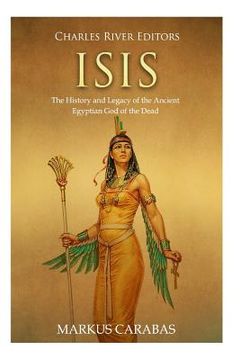Reseña del libro "Isis: The History and Legacy of the Ancient Egyptian God of the Dead (en Inglés)"
*Includes pictures *Includes ancient accounts *Includes online resources and a bibliography for further reading Africa may have given rise to the first human beings, and Egypt probably gave rise to the first great civilizations, which continue to fascinate modern societies across the globe nearly 5,000 years later. From the Library and Lighthouse of Alexandria to the Great Pyramid at Giza, the Ancient Egyptians produced several wonders of the world, revolutionized architecture and construction, created some of the world's first systems of mathematics and medicine, and established language and art that spread across the known world. With world-famous leaders like King Tut and Cleopatra, it's no wonder that today's world has so many Egyptologists. To the ancient Egyptians, as was the case with any society made up of inquiring humans, the world was a confusing and often terrifying place of destruction, death and unexplained phenomena. In order to make sense of such an existence, they resorted to teleological stories. Giving a phenomenon a story made it less horrifying, and it also helped them make sense of the world around them. Unsurprisingly, then, the ancient Egyptian gods permeated every aspect of existence. Isis first appears during the period of Old Kingdom (ca. 2660-2190 BCE) but only later does she take on her most famous role of being a sister-wife of Osiris. Originally, she is simply the mother of Horus and the details surrounding his conception are more obscure. Her absence in the original myths about Osiris is confirmed by the fact that her appearances at Abydos, a famous cult center of Osiris, are scarce until the New Kingdom (ca. 1549-1069 BCE). In fact, Isis had no known cult center throughout the majority of ancient Egyptian dynastic history, though it didn't seem to have a negative effect on her worship. Isis was one of the nine principal deities of the Egyptian pantheon called the Ennead and her hieroglyph was the throne, a glyph that would later connect her with Osiris, whose hieroglyph was a throne and an eye, and royalty in general. In fact, as the goddess of the throne, she came to represent the "mother" of all the kings of Egypt. Regardless of her royal attributes, however, Isis was fundamentally a healer and a peacemaker. Nevertheless, as time went on and Egypt became more influenced by the outside world, Greece and Rome in particular, Isis came to be seen as the wrathful protector of Egypt and its kings. According to the sources, she was "cleverer than millions of gods" and more capable of protecting the country than "millions of soldiers." What is most fascinating about Isis is the agency she has in her myths, particularly the most famous, that of the death and rebirth cycle of Osiris. In this myth she even demonstrates traits of the female trickster, which is considerably less common in world mythology than the male equivalent. According to one New Kingdom source, Isis transformed herself into an old woman in order to fool the divine ferryman between the worlds of the living and the dead, and she also turned herself into a young woman in order to get Seth to admit that his claim for power was unjust. All the while, she created cultural and geographical mainstays - such as the Nile - while being worshipped as a helper goddess. It is curious that, until the 30th Dynasty, Isis was worshipped in the temples of other gods as she did not have a dedicated cult center of her own. During the 30th Dynasty, this changed with two large temples built in her honor in the Nile Delta. Later on, the Ptolemaic and Roman rulers of Egypt would develop these sites and her worship would outlive the draconian abolishment of pagan religion in Egypt and would even be transported out of Egypt as Isis was revered and worshipped at the farthest reaches of the Roman Empire.

